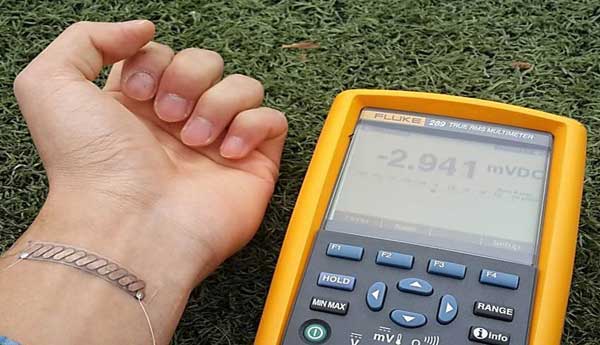
Feature image credit: KAIST.

A new thermoelectric (TE) generator, pictured above, uses the heat of your body to power wearable electronic devices. Unlike other TEs, this highly flexible generator can be bent up to 120 times without decreased performance. Credit: KAIST.
To advance, we need technology. For technology, we need electricity. And if we want electricity, we need energy, whether from a battery or generator.
We’ve reported on all of the above, hailing 2014 the year of wearable tech, covering thin films for biologically-powered medical devices, reporting on a nanogenerator that shows promise for self-powered electronics, and writing endlessly about batteries and the devices that use them. (Need proof? Just type “battery” in the search box above.)
Now, a team from the Korea Advanced Institute of Science and Technology (KAIST) has developed an “extremely light and flexible” glass fabric-based thermoelectric (TE) generator that not only moves with you, but harnesses heat from the human body while doing so.
According to a KAIST press release, the technique employed by the team, headed by electrical engineering professor Byung Jin Cho, “minimizes thermal energy loss but maximizes power output.”
Just how did they do it?
Unlike previous TE generators that used polymers, Cho’s concept had a self-sustaining structure sans the usual ceramic and alumina substrates that siphoned off a good portion of the generator’s thermal energy.
By employing a technique similar to screenprinting, the researchers printed “synthesized liquid-like pastes of n-type (Bi2Te3) and p-type (Sb2Te3) TE materials” onto a glass fabric.

KAIST’s wearable thermoelectric generator is extremely flexible and light. Credit: KAIST
“For our case, the glass fabric itself serves as the upper and lower substrates of a TE generator, keeping the inorganic TE materials in between,” says Cho. “This is quite a revolutionary approach to design a generator. In so doing, we were able to significantly reduce the weight of our generator (~0.13 g/cm2), which is an essential element for wearable electronics.”
When worn as part of a wristband device, KAIST’s supersmall generator—which measures a mere 10 cm x 10 cm—can produce close to 40 mW of electricity based on skin temperature.
“Our technology presents an easy and simple way of fabricating an extremely flexible, light, and high-performance TE generator. We expect that this technology will find further applications in scale-up systems such as automobiles, factories, aircrafts, and vessels where we see abundant thermal energy being wasted,” adds Cho.
Their findings, “Wearable thermoelectric generator fabricated on glass fabric” (DOI: 10.1039/C4EE00242C), were printed in the March 14 issue of Energy & Environmental Science.
For some additional reading, check out Gizmodo’s story on hot (literally speaking) electronics, or this wearable health monitor that uses stretchable electronics to wirelessly supervise your body.
Author
Jessica McMathis
CTT Categories
- Electronics
- Energy
- Material Innovations

